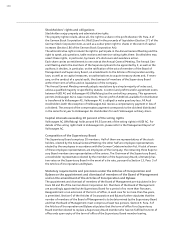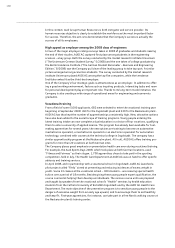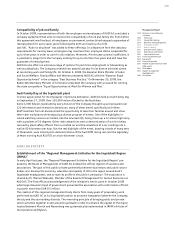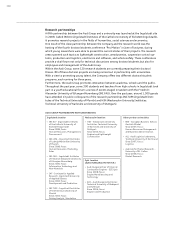Audi 2008 Annual Report Download - page 152
Download and view the complete annual report
Please find page 152 of the 2008 Audi annual report below. You can navigate through the pages in the report by either clicking on the pages listed below, or by using the keyword search tool below to find specific information within the annual report.
133
Management Report
128 Business and underlying
situation
128 The Group
131 Corporate steering
134 Research and development
136 Employee matters
139 Audi in society
141 Environmental aspects
147 Economic environment
150 Course of business
157 Financial performance
159 Net worth
160 Financial position
160 Report on post-balance sheet
date events
161 Risk report
165 Report on expected
developments
169 Disclaimer
High profitability
The Audi Group management’s primary objective within the scope of its “Route 15” strategy is
to achieve sustainable growth. As well as further increasing the market share in key markets,
high profitability in particular is at the focus of all activities. Within the context of this value-
oriented corporate management approach, growth also has to be profitable if it is to meet the
premium standards of the Audi Group.
Sustainable, high profitability is encouraged in particular by continuously reassessing processes
and structures in order to improve efficiency and realize cost-cutting potential, while also im-
plementing wide-ranging measures to permanently optimize material costs and ensure system-
atic investment management.
Most attractive employer
If the Audi Group is to continue the impressive achievements of the past, it will have to continue
to depend on committed and highly skilled employees. Therefore, one of the Company’s core
strategic goals is to enhance its attractiveness as an employer even further. The associated
activities include creating a working environment that demands and encourages the ongoing
development of the entire workforce. The Company acknowledges the great dedication of its
employees not only through performance-based remuneration and profit sharing, but in par-
ticular by staging events like the Audi Family Day 2008. The wide range of measures aimed at
boosting the Company’s attractiveness as an employer also includes flexible working hour pro-
grams and comprehensive preventive health care.
The tremendous success of these measures can be gauged through regular internal employee
surveys. However, external surveys like the one conducted by the renowned trendence Institute
in Berlin (“The German Student Barometer – Business and Engineering Edition,” 8/2008) also
show the Audi Group as being one of the most popular employers of all in 2008. The Company
took first place among engineers, a critical occupation group.
Internal steering system
One of the most important goals of the Audi Group is to consistently increase the Company’s
value. Internal steering is based on return on investment (RoI), which serves as a gauge of the
return on capital employed for various types and scales of investment projects. RoI thus indi-
cates the development of a company’s profitability and is calculated according to the following
formula:
Operating profit after tax
Average invested assets
Return on investment (RoI) = x 100
EUR million 2008 2007
Operating profit after tax 1,940 1,758
Average operating assets 13,157 12,100
– Average non-interest-bearing liabilities 3,343 2,639
= Average invested assets 9,814 9,461
Return on investment (in %) 19.8 18.6
In the 2008 fiscal year, the Audi Group improved its return on investment to 19.8 percent de-
spite an environment dominated by increasingly difficult conditions. This makes the Audi Group
one of the most profitable businesses in the international automotive industry and gives im-
pressive proof of its remarkable competitiveness.
System of remuneration for the Supervisory Board and Board of Management
Information on the system of remuneration for the Supervisory Board and Board of Manage-
ment is provided in the Notes to the Consolidated Financial Statements under Section 48
“Details relating to the Supervisory Board and Board of Management.”
























